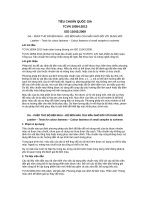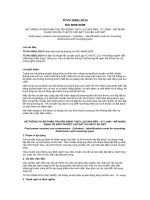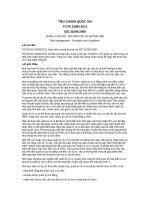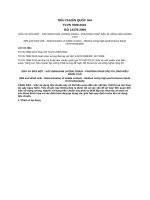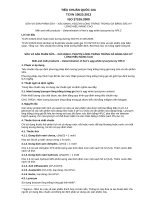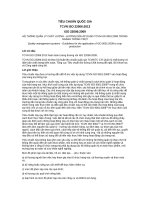ISO 28079:2009 Hardmetals — Palmqvist toughness test
Bạn đang xem bản rút gọn của tài liệu. Xem và tải ngay bản đầy đủ của tài liệu tại đây (220.02 KB, 18 trang )
INTERNATIONAL ISO
STANDARD 28079
First edition
2009-07-15
Hardmetals — Palmqvist toughness test
Métaux durs — Méthode d'essai de dureté de Palmqvist
Reference number
ISO 28079:2009(E)
© ISO 2009
ISO 28079:2009(E)
PDF disclaimer
This PDF file may contain embedded typefaces. In accordance with Adobe's licensing policy, this file may be printed or viewed but
shall not be edited unless the typefaces which are embedded are licensed to and installed on the computer performing the editing. In
downloading this file, parties accept therein the responsibility of not infringing Adobe's licensing policy. The ISO Central Secretariat
accepts no liability in this area.
Adobe is a trademark of Adobe Systems Incorporated.
Details of the software products used to create this PDF file can be found in the General Info relative to the file; the PDF-creation
parameters were optimized for printing. Every care has been taken to ensure that the file is suitable for use by ISO member bodies. In
the unlikely event that a problem relating to it is found, please inform the Central Secretariat at the address given below.
COPYRIGHT PROTECTED DOCUMENT
© ISO 2009
All rights reserved. Unless otherwise specified, no part of this publication may be reproduced or utilized in any form or by any means,
electronic or mechanical, including photocopying and microfilm, without permission in writing from either ISO at the address below or
ISO's member body in the country of the requester.
ISO copyright office
Case postale 56 • CH-1211 Geneva 20
Tel. + 41 22 749 01 11
Fax + 41 22 749 09 47
Web www.iso.org
Published in Switzerland
ii © ISO 2009 – All rights reserved
ISO 28079:2009(E)
Contents Page
Foreword............................................................................................................................................................ iv
Introduction ........................................................................................................................................................ v
1 Scope ..................................................................................................................................................... 1
2 Normative references ........................................................................................................................... 1
3 Symbols and units ................................................................................................................................ 1
4 Test pieces and sample preparation................................................................................................... 2
4.1 Test piece size and sampling .............................................................................................................. 2
4.2 Surface preparation .............................................................................................................................. 2
4.3 Surface condition.................................................................................................................................. 2
5 Apparatus .............................................................................................................................................. 3
5.1 General................................................................................................................................................... 3
5.2 Indentation............................................................................................................................................. 3
5.3 Indentation and crack measurement .................................................................................................. 3
6 Procedure and conditions of testing .................................................................................................. 3
6.1 Indentations........................................................................................................................................... 3
6.2 Indentation and crack length measurement ...................................................................................... 3
6.3 Test validity ........................................................................................................................................... 5
7 Analysis ................................................................................................................................................. 6
7.1 Vickers hardness .................................................................................................................................. 6
7.2 Toughness............................................................................................................................................. 6
8 Measurement uncertainty .................................................................................................................... 6
9 Test report ............................................................................................................................................. 7
Annex A (informative) Report pro forma — Palmqvist toughness measurements on hardmetals ........... 8
Bibliography ..................................................................................................................................................... 10
© ISO 2009 – All rights reserved iii
ISO 28079:2009(E)
Foreword
ISO (the International Organization for Standardization) is a worldwide federation of national standards bodies
(ISO member bodies). The work of preparing International Standards is normally carried out through ISO
technical committees. Each member body interested in a subject for which a technical committee has been
established has the right to be represented on that committee. International organizations, governmental and
non-governmental, in liaison with ISO, also take part in the work. ISO collaborates closely with the
International Electrotechnical Commission (IEC) on all matters of electrotechnical standardization.
International Standards are drafted in accordance with the rules given in the ISO/IEC Directives, Part 2.
The main task of technical committees is to prepare International Standards. Draft International Standards
adopted by the technical committees are circulated to the member bodies for voting. Publication as an
International Standard requires approval by at least 75 % of the member bodies casting a vote.
Attention is drawn to the possibility that some of the elements of this document may be the subject of patent
rights. ISO shall not be held responsible for identifying any or all such patent rights.
ISO 28079 was prepared by Technical Committee ISO/TC 119, Powder metallurgy, Subcommittee SC 4,
Sampling and testing methods for hardmetals.
iv © ISO 2009 – All rights reserved
ISO 28079:2009(E)
Introduction
Good test methods are those which enable a user or manufacturer to clearly discriminate between different
materials.
Fracture toughness values are required for three reasons:
a) for product design and performance assessment;
b) for selection of materials;
c) for quality control.
A specific International Standard for the toughness of hardmetals 1) has not been developed to date, primarily
because of the difficulty of introducing stable precracks into these tough but hard materials. However,
Palmqvist tests for toughness are widely used because of their perceived apparent simplicity. Cracks are
formed at the corners of Vickers hardness indentations and these can be used to calculate a nominal surface
toughness value. This value is sensitive to the method of measurement and to the method of surface
preparation of the sample. This International Standard outlines good practice to minimize uncertainties due to
these issues.
There are several possible methods for the measurement of the fracture toughness of hardmetals. The results
can be expressed either as a stress intensity factor, in MN·m−3/2, or as a fracture surface energy, in J·m−2.
The range of values for typical WC/Co hardmetals is from 7 MN·m−3/2 to 25 MN·m−3/2. There is a general
inverse trend of hardness against fracture toughness (see [1] and [2] in the Bibliography).
When applied unqualified to hardmetals, “toughness” can have several meanings.
a) Plane-strain fracture toughness, KIc, in MN·m−3/2, is a value obtained from tests on specimens with
appropriate geometries for plane-strain conditions and containing a well-defined geometry of crack. There
is no standard method for hardmetals and different organizations use different test methods for
introducing the precrack.
b) Strain-energy release rate (or work of fracture), G, is an alternative expression for toughness, often
obtained by converting plane-strain toughness, K, to G [i.e. G = K2/E(1 − ν2), where E is Young's modulus
and ν is Poisson's ratio]. G has units of J·m−2. Again, there is no standard method.
c) Palmqvist toughness, W, is a value obtained by measuring the total length of cracks emanating from the
four corners of a Vickers hardness indentation. For a given indentation load, the shorter the crack, the
tougher the hardmetal.
d) Finally, toughness is also widely used, in a loose sense, to describe the empirical relation between
perceived resistance to dynamic impacts. This is neither standardized nor quantified, but is clearly
important for many industrial applications of hard materials. Also, principally for hardmetals, it can be
more realistically assessed through either fatigue tests or high-rate strength tests, rather than a
conventional fracture toughness test.
1) Terminology — There is a range of terms used for this type of material, especially including cemented carbides and/or
cermets, as well as hardmetals. The word “hardmetals” has been used in this document. It includes all hard materials
based on carbides that are bonded with a metal. In ISO 3252 terminology, “hardmetal” is stated to be “a sintered material
characterized by high strength and wear resistance, comprising carbides of refractory metals as the main component
together with a metallic binder phase”. “Cemented carbide” is synonymous with “hardmetal”. A “cermet” is defined as “a
sintered material containing at least one metallic phase and at least one non-metallic phase, generally of a ceramic
nature”.
© ISO 2009 – All rights reserved v
ISO 28079:2009(E)
There is a considerable body of published information on Palmqvist toughness tests for hardmetals (see [5] to
[29] in the Bibliography). Palmqvist toughness, W, is a toughness value obtained by measuring the crack
lengths at the corners of a Vickers indentation. It can be evaluated by making indentations either at a single
load, usually 30 kgf, or from the inverse of the slope of a plot of crack length against load for a range of
applied loads. For hardmetals, the crack depth profile is normally of the Palmqvist type, i.e. independent
shallow arcs emanating from each indentation corner. The measurement of surface crack length is, however,
open to operator error. It is widely recognized that test surfaces are carefully prepared to remove the effects of
residual surface stresses (see [8] in the Bibliography). The test also has a poor fracture-mechanics pedigree
because of the uncertainties associated with residual stresses introduced by the indentation.
One advantage of the Palmqvist method is that parallel measurements are made of sample hardness, which
is required for quality-control purposes. The crack length, and thus toughness measurements, do not therefore
require much more effort and can yield equally useful material characterization data, provided the
measurements are obtained carefully in line with the methods proposed in this International Standard.
This International Standard is based on a “Good Practice Guide for the Measurement of Palmqvist
Toughness” published by the UK National Physical Laboratory in 1998. This International Standard
recommends good practice to minimize levels of uncertainty in the measurement process. The procedure has
been validated through underpinning technical work within the VAMAS 2 ) framework (see [29] in the
Bibliography). An interlaboratory exercise was conducted to generate underpinning technical information on
toughness tests for hardmetals. More than ten industrial organizations participated, either by correspondence,
supply of materials or by conducting tests. Eight organizations were able to complete Palmqvist tests. Good
statistics were obtained on the Palmqvist data that enabled a quantitative assessment of uncertainties to be
performed for this relatively simple test. Single-edge precracked beam data was thought to be closest to the
“true” value, and the mean values from the Palmqvist test data compared reasonably well with these results.
However, care was needed in test piece preparation to ensure a good correlation between data from the
Palmqvist tests and the single-edge precracked beam results.
2) VAMAS, Versailles Project on Advanced Materials and Standards, supports trade in high technology products through
international collaborative projects aimed at providing the technical basis for drafting codes of practice and specifications
for advanced materials. The scope of the collaboration embraces all agreed aspects of enabling science and technology,
i.e. databases, test methods, design methods, and materials technology, which are required as a precursor to the drafting
of standards for advanced materials. VAMAS activity emphasises collaboration on pre-standards measurement research,
intercomparison of test results, and consolidation of existing views on priorities for standardization action. Through this
activity, VAMAS fosters the development of internationally acceptable standards for advanced materials by the various
existing standards agencies.
vi © ISO 2009 – All rights reserved
INTERNATIONAL STANDARD ISO 28079:2009(E)
Hardmetals — Palmqvist toughness test
1 Scope
This International Standard specifies a method for measuring the Palmqvist toughness of hardmetals and
cermets at room temperature by an indentation method. This International Standard applies to a measurement
of toughness, called Palmqvist toughness, calculated from the total length of cracks emanating from the
corners of a Vickers hardness indentation, and it is intended for use with metal-bonded carbides and
carbonitrides (normally called hardmetals, cermets or cemented carbides). The test procedures proposed in
this International Standard are intended for use at ambient temperatures, but can be extended to higher or
lower temperatures by agreement. The test procedures proposed in this International Standard are also
intended for use in a normal laboratory-air environment. They are not intended for use in corrosive
environments, such as strong acids or seawater.
2 Normative references
The following referenced documents are indispensable for the application of this document. For dated
references, only the edition cited applies. For undated references, the latest edition of the referenced
document (including any amendments) applies.
ISO 3878, Hardmetals — Vickers hardness test
3 Symbols and units
For the purposes of this document, the following symbols and units apply.
Symbol Designation Unit
—
A Constant of value 0,002 8 mm
mm
d Indentation-diagonal mean value N·mm−2
N
d1, d2 Indentation-diagonal individual values J·m−2
E Young's modulus kgf·mm−2
kgf·mm−2
F Indentation load (toughness calculations) MN·m−3/2
mm
G Strain-energy release rate kgf
H Hardness
HV(P) Vickers hardness at load P (kgf)
Klc Plane-strain fracture toughness
An Crack length at indent corner
P Indentation load (Vickers hardness method)
© ISO 2009 – All rights reserved 1
ISO 28079:2009(E)
Symbol Designation Unit
T Total crack length mm
tn Tip-to-tip crack length mm
WG Palmqvist toughness N·mm−1 or J·m−2;
1 N·mm−1 = 1 000 J·m−2
WK Palmqvist fracture toughness MN·m−3/2
ν Poisson's ratio —
4 Test pieces and sample preparation
4.1 Test piece size and sampling
Any test piece shape can be used, provided that it can be prepared with a flat surface and a flat opposing face
for making the indentation. Hot mounting in a press gives flat and parallel faces. Cold mounting does not give
flat and parallel faces.
Diamond slicing or electrospark discharge machines are convenient to use for this purpose. However, the
surfaces shall then be polished. It is recommended that 0,2 mm of material be removed before the final polish
to ensure that material typical of the bulk is tested. For example, the ISO Vickers hardness test for hardmetals
(see ISO 3878) specifies the removal of 0,2 mm.
NOTE It has also been suggested, in a dissertation by M. Heinonen (UMIST) [19], that the test piece should be at
least as thick as ten times the crack length. Thinner test pieces might not give representative results because the stress
state will be dependent on the amount of material supporting the indentation and its associated cracks. It can be
convenient to mount the test pieces in hot-setting resins to directly provide flat and parallel faces. However, if the test
pieces are to be subsequently annealed to remove surface residual stresses then this can be a disadvantage, since the
test piece has to be removed from the mount to put it in the annealing furnace (typically 800 °C for 1 h in a vacuum).
4.2 Surface preparation
It is essential to prepare a surface which is flat so that the indentation is of regular geometry. It is
recommended that the flatness be confirmed after the indentation is made, by measuring the diagonal of the
Vickers indentation in orthogonal directions. If the diagonals differ by more than 1 %, the surface is not flat and
the test should be declared invalid.
Grinding should be done wet with metal-bonded 40 µm diamond-impregnated discs, since silicon carbide
wheels introduce larger residual stresses than diamond. The grinding stage produces a planar surface which
then needs to be polished. The minimum recommended sequence of diamond abrasives is at least 30 µm,
followed by 6 µm and 1 µm. Napless cloths should be used for the final stages.
NOTE This process will produce stress-free surfaces if the final polishing stages are sufficiently long to remove all
grinding damage. However, it is difficult to prove that this is the case without extensive comparisons of results from
as-polished and polished/annealed test pieces.
4.3 Surface condition
It has been shown that surfaces free of residual stress are required for consistent results (see [8] in the
Bibliography). No polishing procedure can guarantee a stress-free surface without tedious systematic
measurements which are not feasible on a regular basis. Usually, test pieces are polished so that the
microstructure can be observed and then annealed at 800 °C for 1 h in a vacuum, following the studies
published by Exner [8].
2 © ISO 2009 – All rights reserved
ISO 28079:2009(E)
NOTE The newer grades of material with very fine WC grain sizes (less than about 0,8 µm as measured by the linear
intercept technique on polished and etched sections) developed in recent years since Exner's work are likely to have even
higher surface residual stresses. It might be that longer annealing times or even higher temperatures are required for
these materials. It would probably be sensible to recommend a higher temperature, but future research is needed to
confirm this recommendation. The annealing stage adds to the complexity of the sample preparation process, but ensures
that the surface is free from residual stresses.
If measurements are performed on as-polished surfaces without an anneal, this shall be indicated in the test
report.
5 Apparatus
5.1 General
The indentations shall be introduced into the test piece of interest using test machines calibrated according to
national standards. The shape of the indentation should be checked regularly for damage to the indenter tip.
The diagonal and crack dimensions can be measured using a microscope attached to the indentation test
machine or separately, but it shall have been calibrated against a standard.
5.2 Indentation
Indentation shall be carried out on a Vickers hardness testing machine in accordance with the method in
ISO 3878 for the Vickers hardness test and for verification of the Vickers hardness testing machine. A certified
diamond indenter should be used and accredited by a national body.
5.3 Indentation and crack measurement
Indent diagonals and cracks should be measured using an accredited microscope. The image can be
projected onto a screen which has been calibrated using a stage graticule traceable to national standards.
6 Procedure and conditions of testing
6.1 Indentations
Indentations shall be made in a deadweight hardness machine which is calibrated at least annually. The
recommended procedure is to make indentations using a Vickers diamond indenter with one load, rather than
a series of loads. The indentations should be made at 30 kgf or, if no cracks are visible at this load, at 100 kgf.
Sometimes, even 100 kgf will not provide cracks. Until further research is conducted, this International
Standard recommends that measurements at loads greater than 100 kgf are not valid. Two indentations shall
be made initially and the toughness values for each indentation shall be compared. If they are within the
measurement uncertainty associated with the procedure (see Clause 8), the two measurements are
considered satisfactory. If they differ by more than this uncertainty, a third indentation shall be made and the
result reported as an average with an associated standard deviation. If the two measurements are within the
estimated measurement uncertainty, then an average value of the two measurements is reported without a
standard deviation.
It is also possible to make the measurement of toughness by indenting with a series of loads and plotting the
total crack lengths obtained against the load for each indentation. If this method is used to obtain a value for
WG and WK, then it shall be noted in the test report.
6.2 Indentation and crack length measurement
It is recommended that the indentation diagonal and crack lengths be measured optically at a magnification of
at least ×500 (see Figure 1). The magnification used shall be calibrated for each measurement session using
a traceable grid.
© ISO 2009 – All rights reserved 3
ISO 28079:2009(E)
Either take photographs of the indentation and cracks or project the image onto a measurement screen if a
suitable microscope is available. Measure both indentation diagonals. Record both values. If the diagonals
differ by more than 2 mm at ×500 magnification, the test should be repeated because of a lack of flatness of
the test piece.
There are two methods for measuring the crack length. The results are independent of the method (see [28] in
the Bibliography). Either of the following methods can be used.
a) Method A:
Measure the distance from crack tip to crack tip for both diagonal directions. The total crack length is the
sum of both these values minus the sum of the indentation diagonals (see Figure 1).
NOTE If the magnification is ×500, this method is impractical, because the crack tip to crack tip distance is
usually too large to include in one image.
b) Method B:
Measure individual crack lengths at ×500 from the indentation corner to crack tip for each of the four
cracks. Add them to give a total crack length. If the crack root does not coincide with the tip of the
indentation diagonal, measure the crack length from where the crack initiates along the edge of the
indentation.
Figure 1 — Schematic diagram of Palmqvist indentation characteristics
Hardness:
H = 1,854 4 × P (1)
⎡ 1⎤2
⎢(d1 + d 2 ) × ⎥ © ISO 2009 – All rights reserved
⎣ 2⎦
The indentation load P is usually 30 kgf.
4
ISO 28079:2009(E)
The following are alternative methods for measuring crack length, An, and toughness, W (see Figure 1).
1) Alternative method 1:
i) Measure crack tip to crack tip:
t1 = A1 + A 2 + d1 (2)
t2 = A3 + A4 + d2 (3)
i) Measure indentation diagonals, d1, d2,
ii) Equation for Palmqvist toughness:
WG = P (4)
(t1 − d1) + (t2 − d2 )
2) Alternative method 2:
i) Measure crack lengths A1 to A4 from crack tip to indentation corner:
T = A1 + A 2 + A 3 + A 4 , or (5)
T = (t1 − d1) + (t2 − d 2 ) (6)
ii) Equation for Palmqvist toughness:
WG = P (7)
T
6.3 Test validity
If there is more than one crack emanating from the indentation corner, the indentation should be ignored, as
the measurement is invalid.
If the total crack length is less than 40 µm, the test should be considered of greater uncertainty and a special
note should be made in the test report.
NOTE For a 30 kgf load, this corresponds to a toughness value, WG, of 7 360 N·m−1 (or about 25 MN·m−3/2 for WK)
for a material with a hardness of 1 000 HV30. These materials are likely to have coarse microstructures and the individual
crack lengths at each indentation corner will be no more than one or two grains long. This is too short to be confident that
the crack is sampling a representative volume of hardmetal.
If the indentation diagonals differ by more than 4 µm for an indentation load of 30 kgf, the surface is not
sufficiently flat and the test is invalid; 4 àm at ì500 magnification is 2 mm.
© ISO 2009 – All rights reserved 5
ISO 28079:2009(E)
7 Analysis
7.1 Vickers hardness
Take the average value of the two diagonals, in mm, and convert to a true value, d, in mm, by dividing by the
calibrated value for the magnification. The hardmetal Vickers hardness, HV, is given by the following equation:
HV = 1,854 4 × P (8)
d2
Express as HV30 or HV100 corresponding to the load used, in kgf.
NOTE Various hardness standards are converting to N·mm−2 rather than kgf·mm−2. At present, the International
Standard for the test method for Vickers hardness (ISO 6507-1) uses kgf and therefore this convention is retained in this
International Standard.
The hardness number shall be expressed without decimal places, i.e. to four significant figures if greater than
1 000 HV, or three significant figures if less than 1 000 HV.
7.2 Toughness
Two different values for toughness can be calculated, Palmqvist toughness, WG, and Palmqvist fracture
toughness, WK (see the introduction).
The following equation is for Palmqvist toughness, Method A (single indentation load):
WG = F (9)
T
The following equation is for Palmqvist fracture toughness, Method B (multiple loads):
WK = A HV × WG (10)
For Method B (multiple loads), the ratio F /T is the inverse of the slope of a plot of total crack length against
load. HV is expressed in N·mm−2 and A has the value 0,002 8.
Calculate both values and report with a mean value if two indentations/samples are made, and a mean value
and standard deviation if three or more indentations/samples are made.
The results shall be reported to three significant figures only.
8 Measurement uncertainty
The ability of the Palmqvist method to differentiate between materials depends on the hardness. For 2 000 HV
the uncertainty is ± 10 N·mm−1, for 1 500 HV it is ± 110 N·mm−1, and for 1 250 HV it is ± 550 N·mm−1.
6 © ISO 2009 – All rights reserved
ISO 28079:2009(E)
9 Test report
It is recommended that the pro forma given in Annex A be used for the test report, which shall contain at least
the following information:
a) a reference to this International Standard;
b) material type and condition;
c) test piece identification;
d) location and direction of sampling of the test piece;
e) surface preparation method;
f) indentation load;
g) analysis method;
h) result obtained in tabular or computer file format;
i) validity assessment;
j) all options not specified in this International Standard, or regarded as optional;
k) details of any occurrence which may have affected the result.
© ISO 2009 – All rights reserved 7
ISO 28079:2009(E)
Annex A
(informative)
Report pro forma — Palmqvist toughness measurements on hardmetals
A.1 General
A report pro forma for Measurement Report covering Palmqvist toughness tests on hardmetals is given in A.2.
Typical inputs are included for guidance.
A.2 Report pro forma Table A.1 — Material Comment
Marshalls Hard Metals
Reference Description
Source MHM15C
Material Identifier WC/6 %Co
50 kA·m−1
Test piece Information Composition 0,80 µTm3·kg−1
Procedure Coercivity Rectangular block
As-sintered
Magnetic moment 40 × 5 × 20 mm
Form 40 × 20 mm
Heat treatment/processing ISO XYZ
Size
Polished area
Applicable standard(s)
Organization: Table A.2 — Testing organization
Name: National Physical Laboratory
Signature: E. Bennett
Date:
26 February 2009
8 © ISO 2009 – All rights reserved
ISO 28079:2009(E)
Table A.3 — Indentation parameters
Reference Description Comment
Surface preparation Polished only or
Test procedure Polished and annealed Polished and annealed at 800 °C for
Method 1: single indentation load 1 h in vacuum
Test validity Method 2: multiple indentation loads
Number of indents 30 kgf
Environment Not used
Crack-length measurement method 3
Indent-diagonal measurement method Room temperature, air
Consistency of indentation shape Optical, ×515 (calibrated)
Total crack length > 40 µm Optical, ×515 (calibrated)
Multiple corner cracks Yes, valid test
Yes, valid test
No, valid test
Table A.4 — Results and analysis (use spreadsheet)
Individual readings a Indent diagonal b Hardness Total crack Palmqvist toughness b
Sample code HV30 length b
d1 d2 mean WG WK
1 337 µm N·mm−1 MN·m−3/2
µm µm µm 1 350 162
1 324 168 1 820 13,7
MHM15Ca1 204 204 204 1 337 155 1 750 13,5
1 324 132 1 900 13,9
MHM15Ca2 203 203 203 1 337 143 2 230 15,1
1 357 128 2 060 14,5
MHM15Ca3 206 204 205 1 337 160 2 300 15,4
1 350 142 1 840 13,8
MHM15Cb1 203 205 204 138 2 070 14,6
2 130 14,9
MHM15Cb2 206 204 205
MHM15Cb3 204 204 204
MHM15Cc1 204 204 204
MHM15Cc2 203 205 204
MHM15Cc3 203 203 203
a For 3 samples, 3 measurements/sample.
b To three significant figures.
Table A.5 — Mean values
Hardness mean Palmqvist toughness a
value
Sample code WG WK
HV30 N·mm−1
s MN·m−3/2 s
± 0,70
MHM15C 1 333 2 010 ± 190 14,4
9
a To three significant figures, s (standard deviation), if appropriate.
© ISO 2009 – All rights reserved
ISO 28079:2009(E)
Bibliography
[1] ISO 3252, Powder metallurgy — Vocabulary
[2] ISO 6507-1, Metallic materials — Vickers hardness test — Part 1: Test method
[3] ROEBUCK, B. and ALMOND, E.A. Deformation and fracture processes and the physical metallurgy of
WC/Co hardmetal. Int. Mater. Rev. 1988, 33(2), pp. 90-110
[4] BROOKES, K.J.A. World Directory and Handbook of Hardmetals and Hard Materials, 5th ed,
International Carbide Data, UK, 1992
[5] WARREN, R. and MATZKE, H.J. Indentation testing of a broad range of cemented carbides, Proc 1st Int.
Conf. on Science of Hard Materials, edited by Viswanadham, Rowcliffe and Gurland, Plenum Press,
New York, 1981, pp. 563-582
[6] SHETTY, D.K., WRIGHT, I.G., MINCER, P.N. and CLAUER, A.H. Indentation fracture toughness of WC-Co
composites, J. Mater. Sci., 1985, 20, pp. 1873-1882
[7] SPIEGLER, R., SCHMAUDER, S. and SIGL, L.S. J. Hard Mater. 1990, 1(3), pp. 147-158
[8] EXNER, H.E. The influence of sample preparation on Palmqvist's method for toughness testing of
cemented carbides. Trans. Met. Soc. AIME, 1969, 245, pp. 677-683
[9] VISWANADHAM, R.K. and VENABLES, J.D. A simple method for evaluating cemented carbides. Met.
Trans. A., 1977, 8A, pp. 187-191
[10] PETERS, C.T. The relationship between Palmqvist indentation toughness and bulk fracture toughness
for some WC-Co cemented carbides. J. Mater. Sci., 1979, 14(7), pp. 1619-1623
[11] NIIHARA, K., MORENA, R. and HASSELMAN, D.P.H. Evaluation of KIc of brittle solids by the indentation
method with low crack-to-indent ratios. J. Mater. Sci. Lett., 1982, 1, pp. 13-16
[12] LAUGIER, M.T. Palmqvist cracking in WC-Co composites. J. Mater. Sci. Lett., 1985, 4(2), pp. 207-210
[13] SINGH, S. and RAMAKRISHNAN, P. Palmqvist toughness of cemented carbide alloys. Int. J. Refract. Hard
Met., 1985, 4(1), pp. 27-30
[14] LAUGIER, M.T. Palmqvist indentation toughness in WC-Co composites. J. Mater. Sci. Lett., 1987, 6,
pp. 897-900
[15] LAUGIER, M.T. Palmqvist toughness in WC-Co composites viewed as a ductile/brittle transition.
J. Mater. Sci. Lett., 1987, 6, pp. 768-770
[16] SHIN, Y., CAO, W., SARGENT, G. and CONRAD, H. Effects of microstructure on hardness and Palmqvist
fracture toughness of WC-Co alloys. Mater. Sci. Eng., 1988, A105-A106, pp. 377-382
[17] ZHANG, S.H. and LIU, Y.X. Palmqvist indentation fracture toughness of WC-Co cemented carbide
alloys. Modern Developments in Powder Metallurgy, 19, Orlando, Florida, USA, June 1988. Metal
Powder Industries Federation, USA. pp. 33-41
[18] LAUGIER, M.T. Validation of the Palmqvist indentation approach to toughness determination in WC-Co
composites. Ceram. Int., 1989, 15(2), pp. 121-125
[19] HEINONEN, M. Comparison of Fracture Toughness Values for Cermet Materials, MSc Thesis, 1996,
UMIST, Manchester, UK
10 © ISO 2009 – All rights reserved
ISO 28079:2009(E)
[20] ALMOND, E.A. and ROEBUCK, B. Indentation Experiments in the SEM. SEM Systems and Applications,
University of Newcastle upon Tyne, UK, July 1973, ed. IoP, London & Bristol, pp. 106-111
[21] PALMQVIST, S. Metod att bestämma segheten hos spröda material, särsskilt hårdmetaller.
Jernkontorets. Ann., 1957, 141, p. 300
[22] PALMQVIST, S. Rissbildungsarbeit bei Vickers-Eindrücken als Maβ für die Zähigteit von Hartmetallen.
Arch. Eisenhutternwes., 33, 1962, pp. 629-634
[23] DAWIHL, W. and ALTMEYER, G. Z. Metallk., 55, 1964, pp. 231-237
[24] ALMOND, E.A. and ROEBUCK, B. Some observations on indentation tests for hardmetals, Conf. on
Recent Advances in Hardmetal Production, Loughborough, England, 1979, MPR, pp. 31-1
[25] ALMOND, E.A. and ROEBUCK, B. Extending the use of indentation tests, Int. Conf. on Science of Hard
Materials, Jackson, Wyoming, USA, 1981, Plenum, New York, 1983, pp. 597-614
[26] PINOT, L. and OSTERSTOCK, F. The transition from Palmqvist to median-radial crack systems within
WC-Co cermets. Key Eng. Mater., 1997, 132, pp. 472-475
[27] SCHUBERT, W.D, NEUMEISTER, H, KINGER, G. and LUX, B. Hardness to toughness relationship of fine-
grained WC-Co hardmetals, 14th International Plansee Seminar, V4, Reutte, Austria, May 1997
[28] ROEBUCK, B., BENNETT, E.G., LAY, L.A. and MORRELL, R. NPL(GPG)009, June 1998. The
Measurement of Palmqvist Toughness for Hard and Brittle Materials
[29] ROEBUCK, B. and BENNETT, E.G. Hardmetal Toughness Tests, VAMAS Report No. 48, NPL,
March 2005
© ISO 2009 – All rights reserved 11
ISO 28079:2009(E)
ICS 77.040.10; 77.160
Price based on 11 pages
© ISO 2009 – All rights reserved



